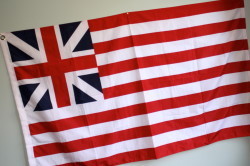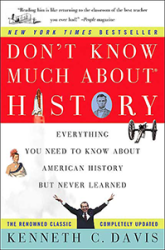Whatever Became Of…56 Signers? (One in a series)

The Grand Flag of the Union, the “first American flag,” originally raised in 1775 and later by George Washington in early 1776 in Boston. The Stars and Stripes did not become the “American flag” until June 14, 1777. (Author photo © Kenneth C. Davis)
TODAY, June 25, 2015, I will begin reposting this series about the 56 signers of the Declaration.
…We mutually pledge to each other our Lives, our Fortunes , and our Sacred Honor.
Strong words that conclude the Declaration of Independence, adopted by the Continental Congress on July 4, 1776.
There is little question that men who signed that document were putting their lives at risk. The identity and fates of a handful of those signers is well-known. Two future presidents –Adams and Jefferson– and America’s most famous man, Benjamin Franklin, were on the Committee that drafted the document.
But the names and fortunes of many of the other signers, including the most visible, John Hancock, are more obscure. In the days leading up to Independence Day, I will offer a thumbnail sketch of each of the signers in alphabetical order. Some prospered and thrived; some did not: How many of those signers actually paid with their lives, fortunes and sacred honor?
-John Adams (Massachusetts) Aged 40 when he signed, he went on to become the first vice president and second president of the United States. Adams died on the 50th anniversary of the Declaration in 1826 at age 90. (Jefferson died that same day)
-Samuel Adams (Mass.) Older cousin to John, Samuel Adams was 53 at the signing. He went on to a career in state politics, initially refused to sign the Constitution because it lacked a Bill of Rights, and was governor of Massachusetts. He died in 1803 at 81.
-Josiah Bartlett (New Hampshire) Inspiring the name of the fictional president of West Wing fame on TV, Bartlett was a physician, aged 46 at the time of the signing. He helped ratify the Constitution in his home state, giving the document the necessary nine states to become the law of the land. Elected senator he chose to remain in New Hampshire as governor. Three of his sons and other descendants also became physicians. He died in 1795 at age 65.
-Carter Braxton (Virginia) A 39-year-old plantation owner, Braxton was looking to invest in the slave trade before the Revolution. Initially reluctant about independence, he helped fund the rebellion and lost a considerable fortune during the war –not because he was a signer, but because of shipping losses during the war itself. He later served in the Virginia legislature and died in 1797 at age 61, far less wealthy than he had been, but also far from impoverished.
-Charles Carroll of Carrollton (Maryland) A plantation owner, 38 years old and one of America’s wealthiest men at the signing, Carroll was the only Roman Catholic signer and the last signer to die. Owner of hundreds of slaves, Carroll considered freeing some of them before his death and later introduced a bill for gradual abolition in Maryland, which had no chance of passage. At age ninety-one, he laid the cornerstone of the Baltimore and Ohio Railroad as a member of its board of directors. He died in 1832 at age 95.
Longer biographical sketches of the Declaration’s signers can be found at this National Park Service site. And read more about the Declaration and the signers in:

DON’T KNOW MUCH ABOUT® THE AMERICAN PRESIDENTS (HYPERION PAPERBACK APRIL 15, 2014)

Don’t Know Much ABout® History: Anniversary Edition (Harper Perennial and Random House Audio)



